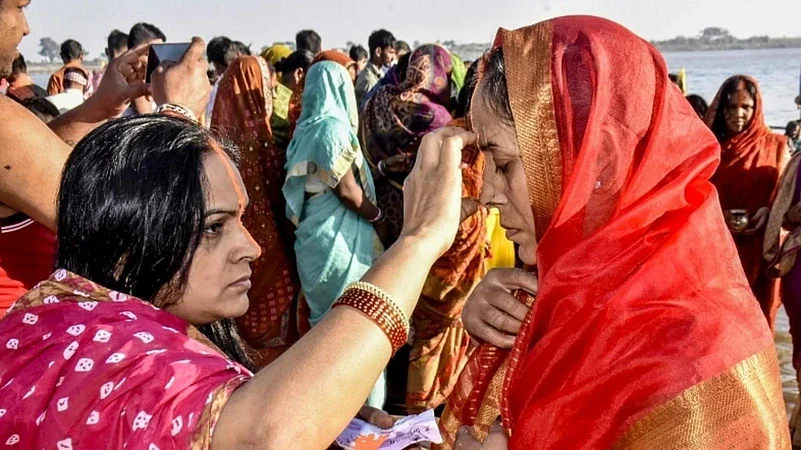As the four-day auspicious festival Chhath is fast approaching, the devotees are excited to celebrate this grand festival of Lord Sun and Chhathi Maiya with great fervour and enthusiasm. The festival is celebrated primarily in Bihar, Uttar Pradesh, Jharkhand, and certain other states. This ancient festival symbolises the worship of nature and the cosmic energy that sustains life on earth. Unlike most Hindu festivals, Chhath Puja is characterized by stringent rituals and environmental awareness, focusing on purity and simplicity. In this article, we will focus on the offerings made during Chhath puja and their importance.
Offerings (Prasad) During Chhath Puja
The offerings (or prasad) in Chhath Puja are significant and are prepared with utmost purity and care. Cleanliness is strictly followed while preparing prasad or offering. It is mandatory to use bamboo baskets where the offerings are placed. On the third day of sandhya arghya, the devotees along with their families throng to river banks with the offering on the bamboo basket on their heads. Each item used in the offerings has its importance. Here is a detailed list of offerings.
Coconut

Coconut is offered to Chhathi Maiya during the sacred festival. The coconut is considered a symbol of purity and fertility. According to belief, coconut is an essential part of offerings and offering coconut fulfills wishes. Also, it marks respect and devotion towards Chhathi Maiya. The coconut is usually placed in a basket or soop, along with other offerings, such as fruits, flowers, and sweets.
Thekua

The beloved sweet cookie of Bihar and Jharkhand is also a quintessential offering to Chhathi Maiya, sister of Lord Sun. Thekua is believed to be auspicious and is prepared with utmost devotion during the festival. Devotees offer these sweet treats as a symbol of gratitude to the Sun God and Chhathi Maiya for bestowing their blessings. The aroma of freshly made thekua fills the air during Chhath Puja, adding to the festive atmosphere.
Betal nuts

Betal buts are offered during Chhath puja; often they are wrapped in betel leaves. Offering betel nuts is considered auspicious and is offered as a mark of respect to the deity. They symbolize purity, prosperity, and good health. This offering is believed to please Chhathi Maiya and seek her blessings for a bountiful harvest and the well-being of the family.
Seasonal fruits

Fruits like bananas, sugarcane, apples, coconuts, and oranges are offered to please the almighty. These fruits signify the abundance of nature and are symbolic of the nourishment provided by the Sun. Seasonal fruits are considered sacred and are offered to the deities as a symbol of gratitude and devotion. The offering should be placed in a soop, along with other offerings such as kheer, roti, and thekua. The fruits are then immersed in the river or pond as a symbol of offering them to the deities.
Kheer (rice pudding)

Kheer is regarded as a holy and fortunate dish that represents reverence and adoration of gods. Kheer is believed to be a pure and sattvic food, making it a fitting offering to the divine. The sweet taste of kheer is said to represent the sweetness of life and the joy of the festival.
Ginger and Turmeric

Ginger and turmeric symbolize health and wellness. These are natural herbs with healing properties, which is why they form a part of the offering. During Chhath Puja, ginger and turmeric are believed to help purify the body and mind of the devotees. They are also said to help connect the devotees with the Sun god.
Sugarcane

Sugarcane is considered auspicious and is offered to maintain sweetness, prosperity, and abundance during Chhath puja to Chhathi Maiya. Sugarcane is considered a sacred offering and is used in various rituals throughout the festival.
Diya (Earthen lamps)

Diya or earthen lamps are considered pure; these lamps, made from clay, are lit during the puja as offerings to the deities. The soft glow of the diyas symbolizes purity, knowledge, and the victory of light over darkness. The use of earthen lamps during Chhath Puja holds immense cultural and religious significance and is believed to bring blessings, prosperity, and good health to the devotees.
Milk and water

Water and milk are essential offerings that symbolize purity and life. Arghya with milk and water is offered to the rising and setting sun as a gesture of respect and gratitude.
Why do women apply vermillion (sindoor) from nose to forehead?

Sindoor, or vermillion, is a sign of marital bliss and longevity of the husband and symbolises deep-rooted traditions and beliefs that make the festival a unique one. It is believed that applying vermilion to the nose during this festival brings blessings for a long and prosperous life for the husband. This tradition is rooted in the Hindu belief that the husband is considered the equivalent of God. By applying vermilion, women express their devotion to their husbands and seek blessings for their well-being.
Conclusion
Chhath Puja is not just a religious festival but a way of life for those who celebrate it with devotion and purity. The offerings, rituals, and prayers symbolize the human connection with nature, self-discipline, and the importance of family and community. By worshipping the Sun God and Chhathi Maiya, devotees express their gratitude for the bounties of nature and seek blessings for health, wealth, and happiness.

















